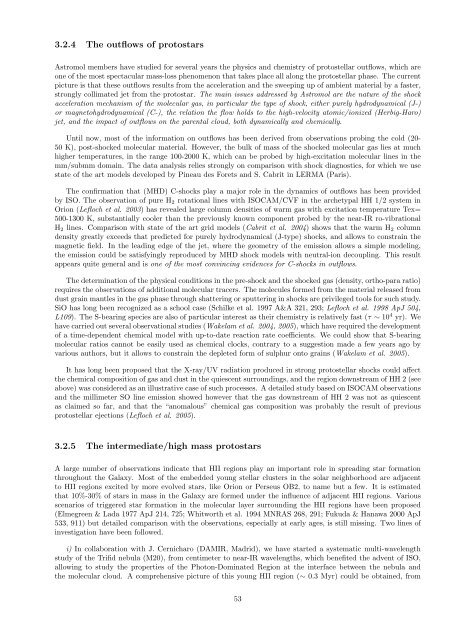Untitled - Laboratoire d'Astrophysique de l'Observatoire de Grenoble
Untitled - Laboratoire d'Astrophysique de l'Observatoire de Grenoble
Untitled - Laboratoire d'Astrophysique de l'Observatoire de Grenoble
Create successful ePaper yourself
Turn your PDF publications into a flip-book with our unique Google optimized e-Paper software.
3.2.4 The outflows of protostars<br />
Astromol members have studied for several years the physics and chemistry of protostellar outflows, which are<br />
one of the most spectacular mass-loss phenomenon that takes place all along the protostellar phase. The current<br />
picture is that these outflows results from the acceleration and the sweeping up of ambient material by a faster,<br />
strongly collimated jet from the protostar. The main issues addressed by Astromol are the nature of the shock<br />
acceleration mechanism of the molecular gas, in particular the type of shock, either purely hydrodynamical (J-)<br />
or magnetohydrodynamical (C-), the relation the flow holds to the high-velocity atomic/ionized (Herbig-Haro)<br />
jet, and the impact of outflows on the parental cloud, both dynamically and chemically.<br />
Until now, most of the information on outflows has been <strong>de</strong>rived from observations probing the cold (20-<br />
50 K), post-shocked molecular material. However, the bulk of mass of the shocked molecular gas lies at much<br />
higher temperatures, in the range 100-2000 K, which can be probed by high-excitation molecular lines in the<br />
mm/submm domain. The data analysis relies strongly on comparison with shock diagnostics, for which we use<br />
state of the art mo<strong>de</strong>ls <strong>de</strong>veloped by Pineau <strong>de</strong>s Forets and S. Cabrit in LERMA (Paris).<br />
The confirmation that (MHD) C-shocks play a major role in the dynamics of outflows has been provi<strong>de</strong>d<br />
by ISO. The observation of pure H2 rotational lines with ISOCAM/CVF in the archetypal HH 1/2 system in<br />
Orion (Lefloch et al. 2003) has revealed large column <strong>de</strong>nsities of warm gas with excitation temperature Tex=<br />
500-1300 K, substantially cooler than the previously known component probed by the near-IR ro-vibrational<br />
H2 lines. Comparison with state of the art grid mo<strong>de</strong>ls (Cabrit et al. 2004) shows that the warm H2 column<br />
<strong>de</strong>nsity greatly exceeds that predicted for purely hydrodynamical (J-type) shocks, and allows to constrain the<br />
magnetic field. In the leading edge of the jet, where the geometry of the emission allows a simple mo<strong>de</strong>ling,<br />
the emission could be satisfyingly reproduced by MHD shock mo<strong>de</strong>ls with neutral-ion <strong>de</strong>coupling. This result<br />
appears quite general and is one of the most convincing evi<strong>de</strong>nces for C-shocks in outflows.<br />
The <strong>de</strong>termination of the physical conditions in the pre-shock and the shocked gas (<strong>de</strong>nsity, ortho-para ratio)<br />
requires the observations of additional molecular tracers. The molecules formed from the material released from<br />
dust grain mantles in the gas phase through shattering or sputtering in shocks are privileged tools for such study.<br />
SiO has long been recognized as a school case (Schilke et al. 1997 A&A 321, 293; Lefloch et al. 1998 ApJ 504,<br />
L109). The S-bearing species are also of particular interest as their chemistry is relatively fast (τ ∼ 10 4 yr). We<br />
have carried out several observational studies (Wakelam et al. 2004, 2005), which have required the <strong>de</strong>velopment<br />
of a time-<strong>de</strong>pen<strong>de</strong>nt chemical mo<strong>de</strong>l with up-to-date reaction rate coefficients. We could show that S-bearing<br />
molecular ratios cannot be easily used as chemical clocks, contrary to a suggestion ma<strong>de</strong> a few years ago by<br />
various authors, but it allows to constrain the <strong>de</strong>pleted form of sulphur onto grains (Wakelam et al. 2005).<br />
It has long been proposed that the X-ray/UV radiation produced in strong protostellar shocks could affect<br />
the chemical composition of gas and dust in the quiescent surroundings, and the region downstream of HH 2 (see<br />
above) was consi<strong>de</strong>red as an illustrative case of such processes. A <strong>de</strong>tailed study based on ISOCAM observations<br />
and the millimeter SO line emission showed however that the gas downstream of HH 2 was not as quiescent<br />
as claimed so far, and that the “anomalous” chemical gas composition was probably the result of previous<br />
protostellar ejections (Lefloch et al. 2005).<br />
3.2.5 The intermediate/high mass protostars<br />
A large number of observations indicate that HII regions play an important role in spreading star formation<br />
throughout the Galaxy. Most of the embed<strong>de</strong>d young stellar clusters in the solar neighborhood are adjacent<br />
to HII regions excited by more evolved stars, like Orion or Perseus OB2, to name but a few. It is estimated<br />
that 10%-30% of stars in mass in the Galaxy are formed un<strong>de</strong>r the influence of adjacent HII regions. Various<br />
scenarios of triggered star formation in the molecular layer surrounding the HII regions have been proposed<br />
(Elmegreen & Lada 1977 ApJ 214, 725; Whitworth et al. 1994 MNRAS 268, 291; Fukuda & Hanawa 2000 ApJ<br />
533, 911) but <strong>de</strong>tailed comparison with the observations, especially at early ages, is still missing. Two lines of<br />
investigation have been followed.<br />
i) In collaboration with J. Cernicharo (DAMIR, Madrid), we have started a systematic multi-wavelength<br />
study of the Trifid nebula (M20), from centimeter to near-IR wavelengths, which benefited the advent of ISO,<br />
allowing to study the properties of the Photon-Dominated Region at the interface between the nebula and<br />
the molecular cloud. A comprehensive picture of this young HII region (∼ 0.3 Myr) could be obtained, from<br />
53




